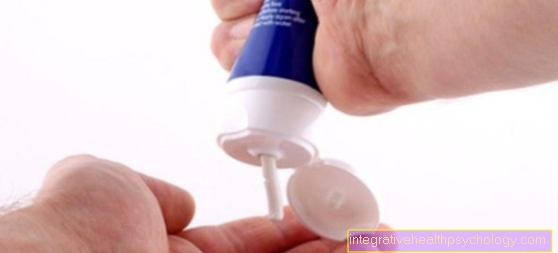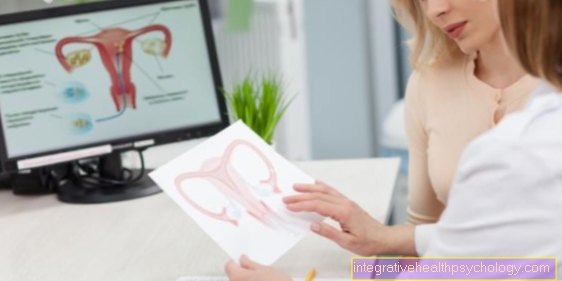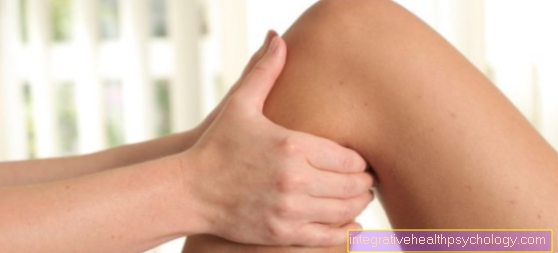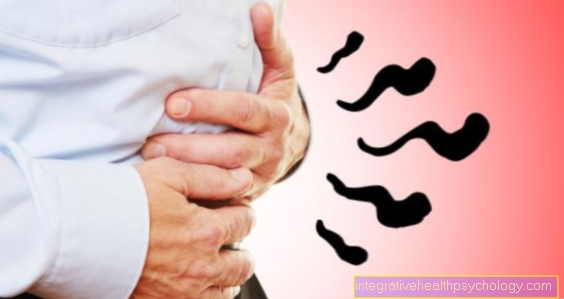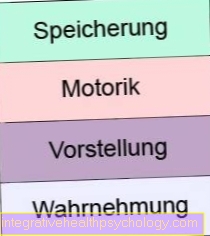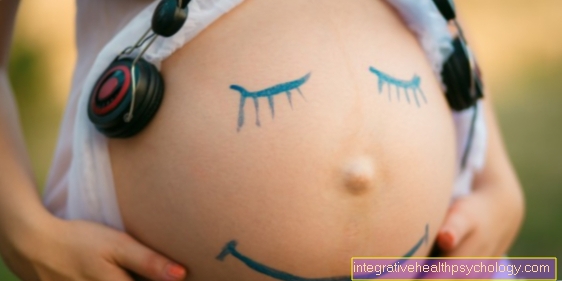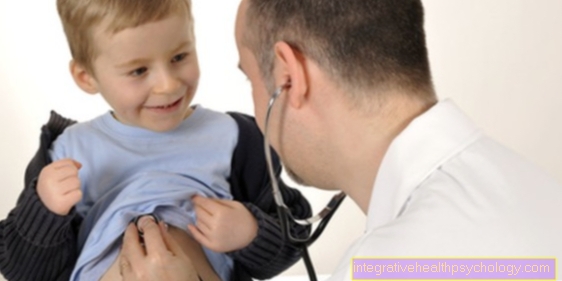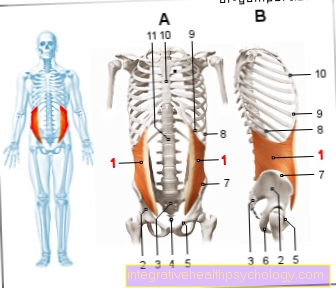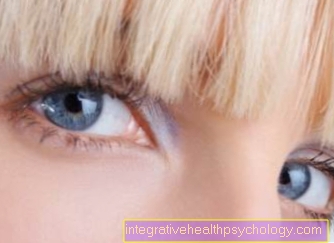Pain in the heel
Different causes of heel pain
Heel pain is a common symptom with many different causes. Are particularly common Heel spur and the inflammation of the Plantar fascia Cause of pain. But also Incorrect loads or excessive strain can lead to heel pain as well wrong footwear. Therapy is not always easy and often tedious.

Where does the pain occur?
Back heel pain (dorsal heel spur)
Pain in the back of the heel can indicate what is known as "achillodynia".
This term refers to a pain syndrome of the Achilles tendon, i.e. the attachment of the calf muscles to the heel bone. The pain in the back of the heel caused by this condition is an inflammatory reaction to mechanical damage to the tendon tissue.
In most cases, the pain in achillodynia is located approximately one to six centimeters above the base of the calcaneus.
The direct cause of the pain on the back of the heel is chronic overloading of the Achilles tendon. In particular, constant, uniform movements, for example when running long distances, can cause such overload.
In addition, this form of back heel pain occurs in diseases of the ankle joint and / or foot malformations. In this context, the so-called dorsal heel spur plays a crucial role.
The affected persons suffer from permanent irritation of the Achilles tendon due to the dorsal heel spur. As a result, the smallest trauma occurs in the tendon tissue, which leads to severe pain in the back of the heel.
The dorsal heel spur is provoked in most cases by poor posture, incorrect loading and / or incorrect footwear. For this reason, its formation should be prevented in childhood.
The development of a dorsal heel spur, which can lead to severe pain in the back of the heel, can be avoided primarily by choosing suitable shoes. Adults who already suffer from pain in the back of the heel should regularly relieve the affected foot if possible. Especially shoes without a heel cap and ankle-high shoes can provide adequate pressure relief for the Achilles tendon.
In addition, the dorsal calcaneal spur can be treated by surgically removing the excess bone. Affected patients should note in this context that the remaining scarred tendon tissue can still lead to pain in the back of the heel.
However, due to the anatomical proximity to the growth plate, surgical correction of a dorsal calcaneal spur can only be carried out after the skeletal has grown, i.e. at the age of 16 to 17 years.
Pain on the inside
Heel pain, especially if it exists on the inside, can be caused by a so-called Arched feet arise.
Here it comes to a Weakness of tendons and ligamentswho usually do the Longitudinal vault of the foot should be maintained. A drop in the arch of the foot leads to a complete Change of staticsso that the stress points on the foot also change. This creates an increased Pressure load on the inside the heel, which can cause pain as a result. Also a lower heel spur or one Inflammation of the plantar tendon, which is a large tendon in the sole of the foot, can cause pain in the inner heel area.
When does your pain occur?
Appointment with ?

I would be happy to advise you!
Who am I?
My name is dr. Nicolas Gumpert. I am a specialist in orthopedics and the founder of .
Various television programs and print media report regularly about my work. On HR television you can see me every 6 weeks live on "Hallo Hessen".
But now enough is indicated ;-)
Athletes (joggers, soccer players, etc.) are particularly often affected by diseases of the foot. In some cases, the cause of the foot discomfort cannot be identified at first.
Therefore, the treatment of the foot (e.g. Achilles tendonitis, heel spurs, etc.) requires a lot of experience.
I focus on a wide variety of foot diseases.
The aim of every treatment is treatment without surgery with a complete recovery of performance.
Which therapy achieves the best results in the long term can only be determined after looking at all of the information (Examination, X-ray, ultrasound, MRI, etc.) be assessed.
You can find me in:
- Lumedis - your orthopedic surgeon
Kaiserstrasse 14
60311 Frankfurt am Main
Directly to the online appointment arrangement
Unfortunately, it is currently only possible to make an appointment with private health insurers. I hope for your understanding!
Further information about myself can be found at Dr. Nicolas Gumpert
Pain on occurrence (lower heel spur, plantar fasciitis)
In the case of pain in the heel, which mainly occurs when standing up, a so-called "lower heel spur"Are available. The lower heel spur is one of the most common degenerative changes in the bony foot. On average, the typical age of onset is between 40 and 60 Years. The lower heel spur is a bony protrusion in the area of the inner calcaneal body immediately below the heel. A lower heel spur can lead to severe heel pain in the affected person, the intensity of which increases especially when standing up.
One direct cause of the development of a lower heel spur is one chronic pressure and tensile load the tendons on the calcaneus body. Due to this stress, pronounced remodeling processes and spur-like new bone formation in the area of the lower calcaneus occur over time.
Both increasing age and severe obesity (Obesity), as well as excessive or incorrect loading and unsuitable footwear can multiply the risk of developing pain in the heel, which occurs especially when standing up.
In addition, pain down on the heel can be related to a so-called Plantar fasciitis stand. Plantar fasciitis is an inflammatory disease of the tendon plate on the underside of the foot.
Affected individuals typically experience severe pain at the bottom of the heel. This pain occurs at the beginning of the disease, especially when standing up and under stress, for example when jogging.
In the further course, the pain in the heel typical of plantar fasciitis can persist even at rest. Causes for the development of a plantar fasciitis are Leg length differences and / or muscular imbalances. Above all, muscular impairment of the hips, an imbalance in the lumbar spine muscles and knee joint diseases can increase the risk of developing plantar fasciitis.
In addition, pain in the heel, which occurs mainly when standing up, can be provoked by congenital or acquired malpositions of the foot. In the long run, only targeted medical treatment can help relieve the pain in the heel in the long term. For this reason, people who suffer from corresponding pain symptoms should consult a specialist as soon as possible.
Pain after rest
Achilles tendinitis can be a possible cause of heel pain after resting. The cause of the inflammation is in most cases one Overload due to intense training or unusual loads such as standing on a slope for a long time or hiking. Here it comes to Micro injuries in the tendonwhich, however, cannot fully heal due to regular overload. The patient has Inflammation of the Achilles tendon especially pain after rest breaks, which makes the pain particularly evident in the morning after getting up. This heel pain is also called Starting pain designated. In addition, there can also be a swelling and Redness occur in the heel area. At a chronic inflammation the pain can already appear at rest. To treat the inflammation is above all one Relief necessary. Sports activities should therefore be avoided in the foreseeable future. Symptomatic also help Medicationwho have both a pain reliever as well as one anti-inflammatory Have an effect. Preparations from the group of are particularly suitable here non-steroidal anti-inflammatory drugs (NSAIDs) such as diclofenac or ibuprofen. If this does not help, there is also the option of injecting the drug cortisone.
Pain in the morning
Pain in the heel, which occurs mainly in the morning or after resting, is often related to the so-called "Achillodynia“.
Achillodynia is a disease of the Achilles tendon that can lead to severe pain due to microtrauma.
This disease occurs almost exclusively in athletic people and is based on chronic overloading of the tendon attachment on the heel bone. Achillodynia is considered to be the result of many years of incorrect or excessive strain on the foot.
The typical symptoms of achillodynia include exercise-dependent pain, which is mainly localized in the area of the lower leg and heel. In addition, the majority of affected patients describe pain that occurs in the morning after getting up (so-called starting pain) and decrease in intensity with normal exercise.
However, as the disease progresses, pain in the heel can also occur, which persists even when the patient is at rest.
People with corresponding pain symptoms should urgently consult a specialist. Only in this way can targeted treatment be initiated and consequential damage prevented.
For the treatment of achillodynia, which leads to heel pain especially in the morning, come mainly non-operational Measures in question. The early detection of the disease and the rapid initiation of a suitable therapy can prevent progress and alleviate the pain in the heel.
In addition to achillodynia, heel pain, which occurs mainly in the morning, can also be associated with a Arthrosis of the ankle in association with. Typically, the affected patients suffer from pronounced starting pain in the morning. The pain in the heel may subside as the person continues to move. Walking and standing can be almost impossible, especially in the morning, so that the patient concerned has to use crutches.
Pain during pregnancy
At the end of their pregnancy in particular, many women suffer from severe heel pain.
The main cause of this pain is usually the acute weight gain of the expectant mother. Due to the increasing body weight, there is a significant increase in the load on the bony foot while standing and walking.
In addition, the expectant mother's posture typically changes during the course of pregnancy. As a result, there are pronounced changes in the area of the arch of the foot, so that there is a gradual decline in the longitudinal arch in the course of pregnancy. These factors can be particularly stressful for the bones, tendons and muscles of the foot and lead to severe pain in the heel.
In addition, water retention (Edema) in the area of the feet and lower legs lead to the normally fitting footwear becoming too tight and irritating the heel.
However, targeted treatment of heel pain is difficult, especially during pregnancy.
Medicines may only be taken after careful consideration and should always be used sparingly. For this reason, women who experience heel pain during pregnancy should take pressure off the affected foot at regular intervals. Raising your feet can also help prevent water retention.
When choosing footwear, care should be taken to ensure that the shoes are not too tight, even at the end of the pregnancy.
Possible diseases as the cause
inflammation
Inflammation of the Plantar fascia is one of the most common causes of heel pain. The plantar fascia is a strong ligament that extends on the sole of the foot from the heel to the toes.
This ligament is tense when standing and walking and thus particularly stresses the attachment point of the ligament on the heel bone. Heavy friction or too long exposure can cause the Starting point of the plantar fascia inflame, causing pain in the heel. Particularly unusually heavy load, like one intense hike without previous training or unfamiliar new sporting activities can cause inflammation. Also Obesity or Misaligned feet (Sagittarius and Arches foot) increase the risk of inflammation.
In most cases, however, no specific triggering factor can be found. Also are common shortened calf muscles to find which lead to greater stress on the plantar fascia.
Heel spur as a cause of heel pain
Of the Heel spur is a bony one thorn-like extension on the underside of the calcaneus (Calcaneal tuberosity). This bony formation usually arises at the point of attachment of overstrained tendons or when there is inflammation. About 10-20% of patients with calcaneal spurs show no symptoms.
In other cases, the causative inflammation can cause pain, or pressure pain occurs due to tight footwear in the area of the heel spur.
Injuries as the cause
Muscular or bony injuries in the heel area are also possible. While these types of injury are relatively rare, they can be in an accident Heel bone break, causing severe acute pain. In addition, the attachment tendon on the heel can be stretched or torn, which can also cause severe symptoms. Long-term overload can also lead to a fatigue fracture of the heel.
Rheumatic disease
The illness rheumatism can be done on everyone bone or. joint cause pain in the body. So also in the area of the heel. It is about a Autoimmune diseasewhich is not triggered by other causes, but is genetically predisposed. There is severe pain when moving in the heel area.
Improper loading
A Improper loading of the foot and thus the plantar fascia can also cause pain in the heel, a inflammation and one Heel spur to lead. The incorrect load means both Overload through unfamiliar sporting activities, as well as bad ones Load distribution due to the wrong footwear. But also Obesity (BMI> 25) alone can trigger heel pain.
Since the entire body weight is on the Feet This can lead to heel pain, especially when walking longer.
Figure pain ankle

Foot pain
- Achilles tendonitis /
Achilles tendon rupture - Broken bones - toes,
Metatarsus, tarsus
(here outer ankle fracture) - Ligament stretch / torn ligament
at the ankle - Lower and upper heel spurs
Calcaneus spur - Hammer toe and claw toe
(Deformities of the toe bones)
Digitus malleus - Plantar warts
Verrucae plantares - Hallux valgus -
(Deviation of the big toe
in the base joint) - Hallux rigidus -
(Joint wear of the
Metatarsophalangeal joint) - Inflamed nails / nail fungus
- Osteoarthritis / arthritis -
degenerative change of
Joints / inflammation of the joints
You can find an overview of all Dr-Gumpert images at: medical illustrations
Diagnosis

If the heel pain persists for a long time and does not go away by itself, a doctor should be consulted. In the anamnesis are especially those Localization of pain, of the Pain character and the Duration of pain important. Also underlying diseases like rheumatism or Diabetes mellitus should be mentioned. The heel is then examined clinically. A heel spur can be felt well here. In addition, the patient reports increasing pain in most cases when pressure is applied to the heel spur.
In order to make a reliable diagnosis of a calcaneal spur, the X-ray diagnostics a meaningful procedure. On the X-ray of the foot in two planes, the bony structures, and thus also the heel spur, can be easily assessed. If the heel pain is only moderately severe and there are no palpable findings, the X-ray examination can be dispensed with.
In addition, during the clinical examination Misaligned feet recognize what cause of the pain may be. To a inflammatory Genesis or a autoimmunological To exclude causes such as rheumatism, the inflammation parameters and special antibodies in the blood are determined in a laboratory. An ultrasound examination (Sonography) can provide information about the diagnosis, for example whether a effusion or a abscess exist.
Therapy heel pain
In most cases, one is enough for heel pain conservative therapy out to effectively treat the heel pain.
This form of therapy does not serve to eliminate the Heel spurbut the treatment of inflammatory and pain-causing changes in the heel. Conservative therapy one inflamed plantar fascia consists among other things of one Stretching therapy the shortened calf muscles. This is intended to relieve the plantar fascia when walking and standing. In this way, the inflammation can heal better and a new inflammation can be prevented. The stretching exercises have to be done for several months to be successful.
This should once or twice a day for 5-10 minutes the stretching occur. Even after the period of active stretching, the calf muscles should continue to be stretched regularly to prevent further shortening and thus the development of renewed inflammation or a heel spur.
There are also numerous orthopedic aidswhich can relieve heel pain or prevent it from developing. For one, can Shoe insoles support the longitudinal arch of the foot and thus the plantar fascia. On the other hand, the deposits are used to correct Misaligned feetwhich can cause heel pain over time. Heel pad or Heel cushion with a recess in the area of the heel bone protect the heel from friction on the shoe and relieve pain. This is particularly helpful in the case of a heel spur, which causes pain due to the pressure in the shoe.
Also physiotherapeutic methods as the Cold therapy can relieve the pain in the heel. The cooling should only take place 5-10 minutes several times a day and serves to reduce inflammation and decongestion. Likewise can Heat treatments, the Shock wave therapy or one X-ray stimulus irradiation be applied. All of the above-mentioned measures are usually not successful individually, but in combination. For this reason, one treatment is not enough to relieve the pain.
Often months of regular therapy with various components is necessary to eliminate the pain. If necessary, in addition to conservative measures, you can also drug therapies become necessary. Serve here pain reliever and anti-inflammatory Medicines of healing. However, these drugs should not be taken permanently. Furthermore, they are only used for acute treatment, but are no protection for the recurrence of heel pain.
If this therapy is also not sufficient, in very rare cases the surgery advised. Here, the excess bone in a heel spur is removed in order to relieve the pain. However, the operation is associated with risks and often requires some time for follow-up treatment. This, too, cannot prevent a relapse if no additional physiotherapy or orthopedic measures are used.
Heel pain in the child
A child may experience pain in the heel from a Calcaneal apophysitis come. This is where the Growth plate of Heel bone to a disorder. A Apophysis is the medical term for one Osseous processthat serves as a base for muscles, tendons or ligaments. The Achilles tendon attaches to the apophysis of the calcaneus. The disturbance leads to a Softening of the processresulting in pain in the heel. The calcaneal apophysitis is during growth the number one cause of heel pain. Boys who are active in sport are particularly affected. But obesity also seems to play a role in the disease, as it is one Imbalance between exercise capacity and overwork comes. In most cases, both feet are affected. With the disease there is one Pressure sensitivity in the heel area, which may also become a swelling can lead. The main symptom, however, is the pain in the heel, which occurs especially when walking or running. Exercise should be avoided for about 4-6 weeks to treat the condition. It may also be helpful to wear Heel pads or one Heel wedge be. The calcaneal apophysitis usually heals without any consequences.
Summary
Heel pain can be caused by a number of different causes. However, the most common reasons for heel pain are Overloads in the context of unusual sporting activity Obesity, wrong footwear or Misaligned feet. All of these causes can cause inflammation of the plantar fascia, causing severe pain at the heel attachment point. In addition, the inflammatory Changes to the heel contribute to a bony remodeling and the development of a heel spur, which then also leads to pain. But also chronic diseases like rheumatism, or Accidents can lead to heel pain. In addition to the anamnesis and clinical examination, X-ray diagnostics are an important part of the diagnosis. Inflammation parameters, one Ultrasound examination or one Magnetic resonance imaging can secure the diagnosis. In addition to numerous conservative measures, which physiotherapy exercises and treatments, including orthopedic aids, may in rare cases be one surgery contribute to therapy. In no case should only one form of therapy be used. Because of the multitude of causes and therapeutic options, persistent heel pain should be evaluated by a doctor.



